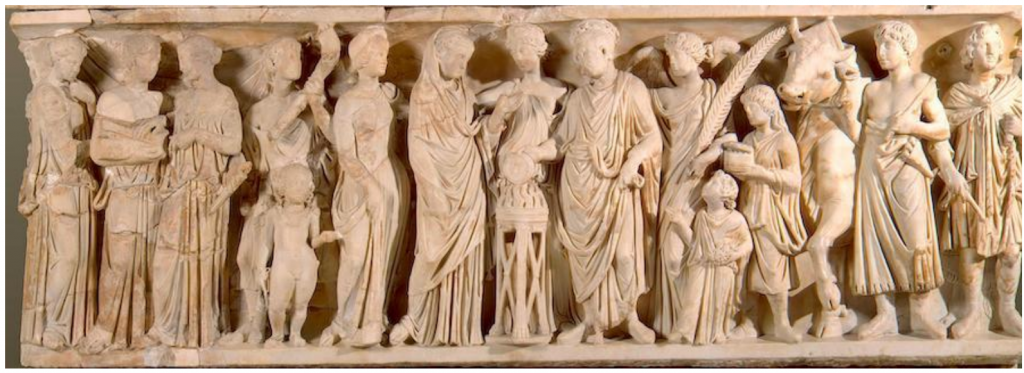While I am the last person who would advocate for whitewashing the ancient world, I do sometimes wonder at the sheer lack of sensitivity shown by examiners when it comes to the selection of the material that Latin GCSE candidates are faced with on the day.
The ancient world abounds with a plethora of stories fit for adaptation. The possibilities are endless. Given this fact, I fail to see the necessity of including stories that even prior to the #metoo era would unquestioningly be classified by all but Andrew Tate’s very worst acolytes as a story of sexual assault. The ancient world abounds with these stories too, and I am not suggesting that we should remove them from the corpus, nor that we should hide the truth of them from students who elect to study this material; it is profoundly important not only that we address these accounts but that we examine what they have to tell us about attitudes towards women and towards consent in the ancient world. But this is an examination I am talking about. Let us remember that there will be a range of students sitting each and every paper, some of whom may (or – according to the statistical reality – will) have experienced sexual assault for themselves. For some of them, the abuse will be ongoing. I’m sorry if this is upsetting news to anyone reading this, but if you work with young people and have undertaken any kind of safeguarding training then it should emphatically not be news to you that this is the case. So, to write an examination that includes a story of sexual assault is either to feign ignorance of the fact that some of our students will have suffered in this way, or is to declare that one simply does not care about the impact that the examination’s contents may have on some of our most vulnerable children, on what amounts to a very important day for them: a day on which their knowledge and hard work is being put to the test.
In an examination, a student who is already in a potentially stressful situation is forced to sit with the material in front of them and process it alone. If they are translating a passage, that means sitting with the material for some considerable period of time. It is clear that the examiners gave no thought to this and I refuse to accept that one has to be some kind of super-woke convert to the concept of trauma-informed education to raise an eyebrow at their monumentally insensitive decision to include this material. Personally, I have some concerns about the spread of trauma-informed practice into education, often pushed by advocates who know nothing about the realities of classroom teaching; I consider some of its most lethal mutations potentially harmful when it interferes with a school’s basic need to provide a robust disciplinary framework for all students to thrive within. Yet humanity and frankly common sense surely teaches us that one should think carefully about the impact that the content of our lessons may have on students, and even more so about the content of an examination that will be sat by thousands of them, on their own, without support.
During my teaching career I worked with the OCR specification, so have come to the WJEC specification in recent years as demand from tutees has increased. I am now at the point where I am looking closely at individual past papers and last week I worked through the contents of the 2020 WJEC GCSE language paper. I was frankly appalled. I have spoken to a couple of contacts who have far more influential voices in the field than I possess and they confirmed to me that they have already raised concerns in the past, to no avail.
So let’s see what everyone else thinks of the content, shall we? The first passage on the 2020 paper consists of Jupiter disguising himself in order to have his wicked way with an innocent young nymph named Callisto. So far, so typical Jupiter and perhaps euphemistic enough for most of us to be broadly okay with the story’s use. However, things do not remain euphemistic. In this particular retelling, Jupiter disguises himself as the virgin goddess Diana, a close companion of Callisto, so that he can enter Callisto’s bed, and the story continues as follows – below is my version of what the students were asked to translate; I have not quoted the Latin extensively, in case they come at me with copyright complaints, but you can view the paper freely here on their own website:
Callisto, when she saw the goddess, was happy; but as soon as Jupiter lay down next to her and gave her a kiss, Callisto realised that she was not a woman but the god. She was terrified. For she had avoided men her whole life, just like Diana. Although she tried to escape, Jupiter held her down easily.
The passing mention that she had “avoided men her whole life, just like Diana” may (one hopes) have gone over the head of most students, but the truth is that it is spelling it out for readers that Callisto is still a virgin. This, plus the clear implication that Jupiter forced himself upon Callisto and physically held her down, is bad enough, but the disturbing content continues:
Having entered the woods with her other companions, Diana greeted Callisto, who was again so terrified that she wanted to run away: she thought that the god was coming back for her. But after she saw the companions, she hurried towards them, crying. “Why are you crying?” they asked. “What happened?” “Nothing,” the unhappy girl replied. After a few days, however, they persuaded Callisto to tell them what had happened.
She thought that the god was coming back for her?! Who thought that line was a great one to include? The Latin is deum ad se redire putavit, a marvellous opportunity to test candidates on the indirect statement with a past tense main verb and a present tense infinitive, well done chaps! Didn’t think about what the statement actually meant, though, did you? I really do despair. (I know I shouldn’t assume that they’re all men but really … what else can one assume? That a woman thought this was okay? I do hope not).
Perhaps worst of all, in a final turn of events, Callisto’s friend and protector Diana turns on her and blames her for her own assault, as does the ever-jealous wife of Jupiter:
Callisto’s companions, shocked by such serious news, hurried to Diana to report the matter to her. Diana, who was very angry, ordered Callisto to leave at once. “You are not blameless” she said. “Do not ever return to us.” Callisto left, very unhappy. She was forced to live in the woods for many months. Meanwhile Juno was watching her. Juno was the wife of Jupiter. Although Jupiter was always trying to deceive her, Juno had found out what he had done. “That very bad nympth will pay for this” she said.
The word (glossed on the exam paper and translated as per the examiner’s instructions as) “blameless” is casta. The phrase could be translated “you are not innocent”, “you are not pure”, “you are not chaste” (our closest equivalent as a direct derivative) or indeed “you are not a virgin”.
The messaging here is clear. A girl is sexually assaulted, is deeply distressed by the assault, is terrified that it will be repeated and finally is told by others that the assault is her fault and that she is sullied goods. How on earth is it possible that this material made it past the huge number of eyes that one presumes (hopes?) get to look at it before it makes it onto the final draft of an examination paper? Did not one of them think to ask whether the content was appropriate or frankly even necessary? Was there no other single story that would have sufficed, from all of the other thousands of ancient stories that are in our possesion? One can only imagine that every single examiner involved was so blissfully ignorant as to the realities of life for some of our young people that they simply did not consider the fact that the material might be unfit for purpose. All I can say is lucky for those who live their own lives knowing so little about other peeople’s pain and distress.
In the past I have written about the content of the text book Suburani and consider some of it inappropriate for younger students, but at least in a text book the material can (and indeed should) be managed by the classroom teacher, who can skip out that section altogether should they decide – as I would – that it is simply not appropriate for their class. If they do decide to tackle the material, they can manage how this is done and provide guidance and a supportive atmosphere for students to respond to it. In an examination, students are left completely exposed, with no gatekeepers to protect them and no safety net to catch them if they end up in freefall. For me, that is simply and emphatically not acceptable and a clear betrayal of our duty of care.

